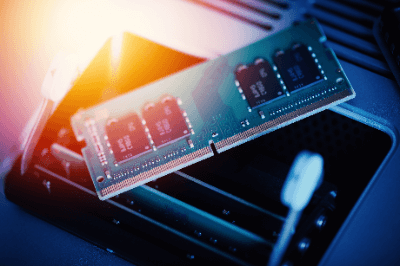What Is a DRAM Module?

DRAM module is a type of volatile storage device (memory) that uses semiconductor elements.
DRAM module is an abbreviation for Dynamic Random Access Memory and is mainly used in personal computers. Because the internal circuit has a very simple structure with a capacitor for storing electric charge and a field-effect transistor (FET), the DRAM module is suitable for large-scale integration in conjunction with the miniaturization of the FET semiconductor process.
Uses of DRAM Modules
DRAM modules are mainly used in personal computers. DRAM modules are used in PCs and industrial machinery control devices that require inexpensive, high-capacity memory because the memory part has a simple structure using capacitors and FETs (field-effect transistors) and can be manufactured at a low unit price for the memory capacity.
DRAM modules are not often used in small devices such as smartphones and mobile terminals because of their power consumption due to their structure of storing information with stored charge in a capacitor and the constant refresh process of writing and reading information to maintain the charge.
Principle of DRAM Modules
The principle of DRAM modules is that they handle a huge amount of data as a storage medium using a binary number, 1 when there is a charge stored in a capacitor in the internal circuit and 0 when there is no charge stored in the capacitor.
When writing data, the charge is accumulated in the capacitor via the FETs and the area where the voltage is high is set to 1 and the area where no charge is accumulated is set to 0. When reading data, the charge in the corresponding area is released, and the reverse operation of writing is used to identify 0s and 1s from the state of the charge stored in the capacitor. This is the mechanism for storing and expressing digital data by performing these operations countless times.
As can be seen from this mechanism, DRAM modules can only retain information while electricity is flowing because a voltage must be applied to the capacitor to accumulate an electric charge. For this reason, DRAM modules are classified as volatile memory.
Other Information on DRAM Modules
1. The Difference Between DRAM Modules and SRAM
Generally, DRAM modules and SRAM are compared when looking to increase the memory capacity of a PC.
Each has its characteristics, and SRAM is superior in terms of memory performance. The major difference is whether the memory style is dynamic or static, with DRAM modules constantly reading and writing information, while SRAM is the opposite. Although SRAM offers high-speed read/write and low power consumption, its disadvantage is that its complex internal circuitry makes it difficult to integrate on a large scale. If a small, inexpensive, large-capacity memory is needed, it is important to select an appropriate memory size from DRAM modules.
2. Differences Between DRAM Modules and Flash Memory
Flash memory is a semiconductor product with similar functions to DRAM modules. Both play different roles on a computer due to their characteristics.
DRAM modules are volatile when no power is supplied, but because of their high processing speed, it is used as the main memory of a computer to temporarily store data needed for arithmetic operations. Flash memory, on the other hand, is non-volatile and does not require a continuous supply of electric charge to retain data, so it is mainly used for long-term data storage.
Comparing the data read/write speeds of flash memory and DRAM modules, DRAM modules are faster, but DRAM modules are more expensive. Compared to magnetic tapes and HDDs, which are used for long-term data storage, flash memory has been used for storage products such as SSDs and USB memories in recent years due to its faster data read/write speed and lower price.
3. Refresh Operation of DRAM Modules
DRAM modules are a volatile device that loses its memory unless power is continuously supplied, so it must be periodically refilled with electric charge. This charge replenishment operation is called a refresh operation. This interval is called a “refresh cycle. Normally, refresh operations are performed at intervals of about 15 microseconds to 60 microseconds.
Since memory cannot be accessed during the refresh operation, it must be performed in as short a time as possible. A memory that can be refreshed in a short period is said to have higher performance.
4. DRAM Modules Memory Capacity Trends
In the 1990s, when Japanese manufacturers were the main players, the DRAM module’s memory capacity increased by a factor of 4 with each generation, from 1 Mbit to 4 Mbit. In the 2000s, however, the increase slowed to 1Gb to 2Gb, and in the 2020s, DRAM module capacity has continued to increase by less than 16Gb.
Contributing to the trend of increasing DRAM module’s storage capacity is semiconductor FET miniaturization process technology. The most advanced process node of the semiconductor process has evolved to a few nm, and active development competition is underway among world-renowned companies and research institutes.